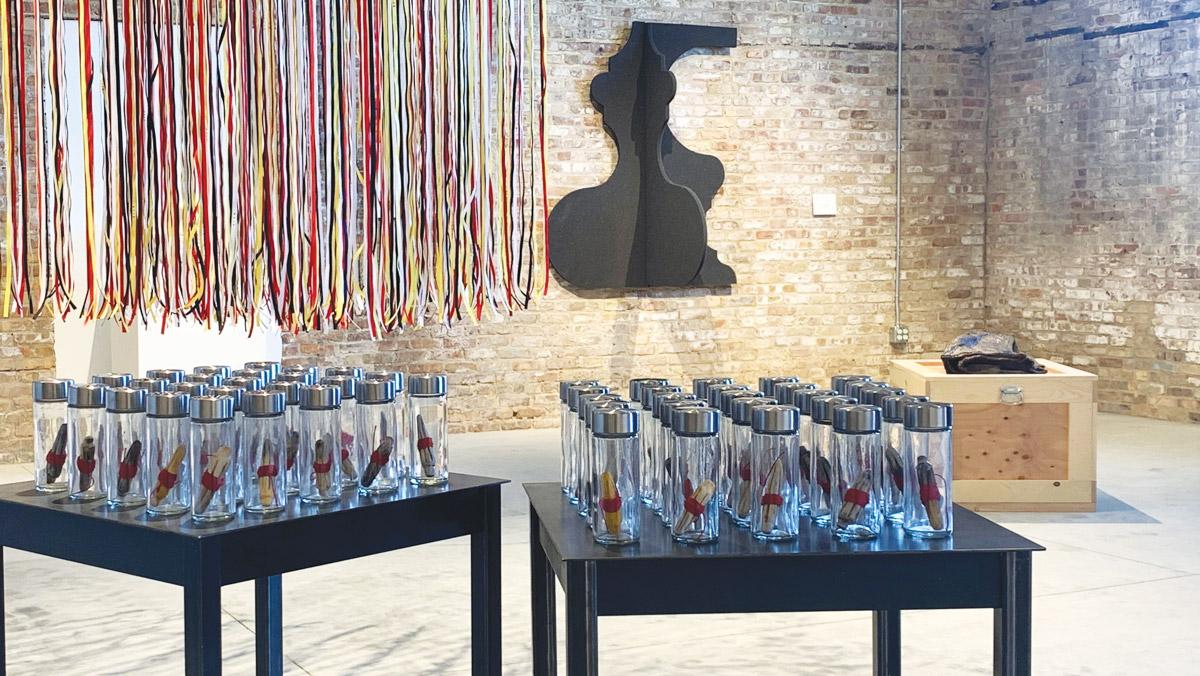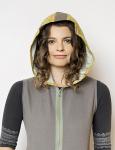Our bodies map the fissures of this cultural moment. Fear of a deadly virus is compounded by the tangible dangers of economic uncertainty, political division, and the emboldened expression of racism, xenophobia, transphobia, and other forms of othering. As the cracks in our system are laid bare, we feel them in our bones.
Although the James Watrous Gallery in Overture Center remains closed due to the Covid-19 pandemic, another space provided me with the opportunity to bring together six Wisconsin artists for a large pop-up exhibition titled Vulnerable Bodies. Held from April 15 to July 24, 2021, at Garver Canvas, a large gallery space in Madison’s historic Garver Feed Mill, Vulnerable Bodies features work that draws on metaphor and proxies from everyday life to address vulnerability and the body.
Erica Hess and Masako Onodera examine aging, disability, and mortality through surrogates such as antique dishes, balloons, and packing blankets. J Myszka Lewis’s mixed-media Bricks and Access Covers toy with our assumptions about strength, weakness, and the value of labor. Works by Demitra Copoulos isolate the hair, organs, and bones of the human body, emphasizing their fragility while reminding the viewer of our shared humanity. Yevgeniya Kaganovich’s sculptural “mouth pieces” evoke the psychology and risk of touch and shared breath. Valaria Tatera’s work challenges us to respond to the twin crises of Indigenous suicide and the murder of Indigenous women, girls, and two-spirit people (two-spirit is a term used to describe First Nations people who have both a male and female spirit within them).
We hope this exhibition inspires you to reflect on fragility, resilience, and all of the vulnerable bodies in our community and the wider world.
Erica Hess, Fear of losing shape, 2018. Bronze, plywood, pine; size variable.
Erica Hess • Appleton
My sculptures are a physical attempt to understand the mutable, continually changing landscape of our emotions by taking seemingly ordinary and universal aspects of life—memory, daily activities—and transforming them into art objects. I use everyday materials and images to consider the passage of time, abandonment, preciousness, loss, and failure. By presenting objects packed into boxes, padded with foam, and wrapped in blankets, I am asking us to consider what is valuable enough to transport and protect, and why.
Masako Onodera, Eruption Necklace, 2007. Plastic grapes, wool, brass; 57 by 7 by 4 inches.
Masako Onodera • Menominee
My work is a means to awaken the viewers and wearers of the objects, to make them conscious of their own bodies and the evanescence of time. In this way, the art object becomes a theater for the indelible physical and emotional memories of the everyday. Both sensual and peculiar, they suggest an experience of the body that is altered by the tactile and visual characteristics of the article itself.
J Myszka Lewis, Access Cover 16, 2019. Dye sublimation print on velvet, mounted to carved wood panel, with flocking; 10 by 10 by 3/4 inches.
J Myszka Lewis • Madison
I build images of hard objects such as bricks and access (manhole) covers out of velvet, and craft text-based work in which words and phrases slip and sway. My working processes often mimic craft and construction techniques, probing the distinctions between what it means “to make” and “to build” as well as the traditionally gendered connotations of these distinct modes of production and their inherent fiscal, cultural, and social values. My subject matter, material choices, and tedious working processes combine to expose the tension between the industrial and the individual.

Demitra Copoulos • Milwaukee
I have explored a wide range of ways to express the human figure. My series of sculpted hairstyles uses hair as a means of portraiture. While typically viewed as personal adornment, hair can also define one’s gender and social status and reflect a historic time. In these works, hair is removed from the context of the body, transforming into an object that distills the essence of a person’s appearance. For what we can’t see, our minds make up a story to fill in the blank.

Yevgeniya Kaganovich • Milwaukee
I make objects that through their use comment on aspects of our existence, our experiences, our interactions, our bodies. It’s important to me that these pieces are not read as sculpture to be observed, but that they invite the viewer’s participation, whether actual or imagined. It’s through this engagement that the meaning of the work is revealed. I strive to create objects that are ambiguous in their nature, their function hindered, their use frustrated, and their origin unclear. The objects in turn create fictions that precipitate out of our own reality and experiences, rendering them as uncertain and unreliable as life itself.

Valaria Tatera • Milwaukee
My Processed series addresses the ongoing crisis of missing and murdered Indigenous women, girls, and two-spirits. All too often the judicial system erases the identities of these people and instead memorializes the crime. But these people were mothers, grandmothers, aunts, sisters, and cousins. They held important roles in their communities. They made decisions, held spots on tribal councils, worked to revitalize our languages, carried our cultural knowledge and memory. Their disappearance goes hand in hand with the commodification and exploitation of Indigenous lands and resources.










